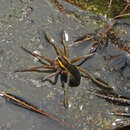Biology
provided by Arkive
Although this species is widely known as the 'raft spider' in Britain, it does not make rafts. It is more appropriately called the fishing spider in Europe, as it hunts by sitting on vegetation next to pools of water, characteristically with the first two pairs of legs held together at an angle and resting on the surface of the water. This allows it to sense the presence of tadpoles, insects and even small fish, which it hauls out of the water. This species also hunts on land amongst vegetation, and on moss (3). The raft spider is able to crawl down water plants if threatened, and can remain below water for around an hour (3).
During courtship, males signal to females by making regular surface waves on the water by jerking their abdomen up and down, and waving their legs in the air in a characteristic fashion. Females are very aggressive towards males, and in some cases they eat prospective mates (5). Female spiders belonging to this family make very large egg sacs, which they carry around beneath their body. When the time for the spiderlings to emerge approaches, the female deposits the egg sac on a leaf and spins a protective silk 'nursery web' around it. She then opens the egg sac slightly, and stands guard over it until the spiderlings emerge (3).
Conservation
provided by Arkive
Conservation action has not been targeted at this widespread species.
Description
provided by Arkive
This large brown and white spider has long, sturdy legs and an oval-shaped abdomen. There are striking pale stripes along the sides of both the carapace and the abdomen (3). These stripes are due in part to a row of white hairs (2). Males are similar in appearance to females, although they have smaller abdomens (3).
Habitat
provided by Arkive
Found in damp, swampy habitats, with patches of water (3), and is especially associated with Sphagnum bogs (4).
Range
provided by Arkive
This spider has a wide but somewhat patchy range in Britain and is widespread in northern Europe (3).
Status
provided by Arkive
This widespread species is not threatened. It is not listed under any conservation designations (3).
Threats
provided by Arkive
This species is not threatened.

